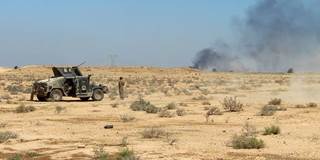The jihadist threat the world is facing is the fourth in a series of increasingly perilous waves. If we are to avoid creating an even more powerful fifth wave, it is imperative that we learn from the mistakes we made in seeking to counter the previous three.
STOCKHOLM – Muscular language has become increasingly prevalent in the debate about how to counter the threat of jihadist terrorism. Television talk-show hosts speculate about when control of Raqqa in Syria or Mosul in Iraq might be wrested from the Islamic State (ISIS), implying that these cities’ liberation will mark, at the very least, the beginning of the end of the problem. And in December, Ted Cruz, a Republican contender in the US presidential race, went so far as to raise the specter of nuclear strikes: “I don’t know if sand can glow in the dark, but we’re going to find out,” he said.
Such simplistic sound bites understate the severity of the challenge. As the International Crisis Group highlights in a recent report, the jihadist threat we are facing is the fourth in a series of increasingly perilous waves. If we are to avoid creating an even more powerful fifth wave, it is imperative that we learn from the mistakes we made in seeking to counter the previous three.
The first jihadist wave occurred when volunteer fighters from the war against the Soviet occupation of Afghanistan returned home and started attacking regimes they considered un-Islamic. This led to the second, far more deadly jihadist wave, as Al Qaeda launched spectacular attacks against the “far enemy,” seeking to draw Western powers into violent confrontation and outright war. The attacks on the United States, on September 11, 2001, marked the crest of this wave.

STOCKHOLM – Muscular language has become increasingly prevalent in the debate about how to counter the threat of jihadist terrorism. Television talk-show hosts speculate about when control of Raqqa in Syria or Mosul in Iraq might be wrested from the Islamic State (ISIS), implying that these cities’ liberation will mark, at the very least, the beginning of the end of the problem. And in December, Ted Cruz, a Republican contender in the US presidential race, went so far as to raise the specter of nuclear strikes: “I don’t know if sand can glow in the dark, but we’re going to find out,” he said.
Such simplistic sound bites understate the severity of the challenge. As the International Crisis Group highlights in a recent report, the jihadist threat we are facing is the fourth in a series of increasingly perilous waves. If we are to avoid creating an even more powerful fifth wave, it is imperative that we learn from the mistakes we made in seeking to counter the previous three.
The first jihadist wave occurred when volunteer fighters from the war against the Soviet occupation of Afghanistan returned home and started attacking regimes they considered un-Islamic. This led to the second, far more deadly jihadist wave, as Al Qaeda launched spectacular attacks against the “far enemy,” seeking to draw Western powers into violent confrontation and outright war. The attacks on the United States, on September 11, 2001, marked the crest of this wave.